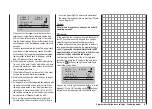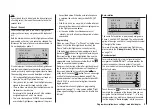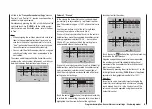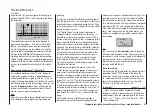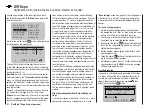
87
Program description: base settings - model helicopter
Note:
A count-down timer is indicated in the basic display by
a flashing colon (:) between the minutes field and the
seconds field.
Phase 2 / Phase 3
You will automatically be in the “normal” flight phase 1
unless you have already assigned a switch to phases 2
or 3.
Both the number and name of this flight phase are fixed
permanently as “normal”, and cannot be changed. For
this reason the “normal” phase is simply concealed, i. e.
it is not displayed as phase 1.
10:01
G3
phase 2
phase 3
hover
speed
–––
–––
rotor direct
right
pitch min
rear
timer
It is also important to understand that the flight phases
have their own inherent priorities which need to be ob-
served, particularly when assigning individual switches.
The underlying scheme can be described as follows:
If all assigned flight phase switches are closed or
•
open, the “normal” flight phase is active.
If only one switch is closed, then the flight phase as-
•
signed to the currently closed switch is active.
If two switches are closed, then the flight phase with
•
the lower number is active.
For example, this would be phase 2 if the switches
assigned to phase 2 and 3 are closed.
The “auto-rotation phase” ALWAYS has precedence
•
over all other flight phases, regardless of the priori-
Auto-rotation
10:01 G3
phase 2
phase 3
hover
speed
–––
pitch min
rear
timer
5
4
autorotat.
The name “Auto-rotation” is permanently assigned to
Phase 4, and CANNOT be altered. The only available
option is to assign a switch to it using the switch symbol
at the right of the screen.
For more information on programming flight phases
please refer to the “
Helicopter mixers
” section starting
on page 114.
Receiver output
For maximum flexibility in terms of receiver socket
assignment, the
mx-16
HoTT software provides the
means to swap over the servo outputs 1 to max. 8;
this is carried out on the second page of the “Receiver
output” sub-menu.
10:01 G3
phase 2
phase 3
hover
speed
timer
5
4
autorotat.
2
receiv out
Touch the central
SET
button of the right-hand touch-key
to move to the next page of the display. Here you can
assign the “control channels” for servos 1 … 8 to any
receiver output you wish to use. However, please note
that the display in “
Servo display
” - which you can ac-
ties outlined above. When the auto-rotation phase
is selected, the switch is always made WITHOUT
DELAY.
With this in mind, you may wish to take the inherent
•
phase priorities into account when assigning names
to the flight phases; see below.
At the servo end the transition does not occur
•
“abruptly”, but with a fixed transition period of about
one second.
Programming
When you select “Phase 2” or “Phase 3” using the arrow
buttons
of the left or right-hand touch-key, the
“Name” field for that flight phase is already framed.
If the default name does not seem appropriate, touch
the central
SET
button of the right-hand touch-key, and
the current setting is shown highlighted. Now use the
arrow buttons of the right-hand touch-key to select an
appropriate name from those available. Touch the
SET
button to conclude the input process.
Now press the
button of the left or right-hand touch-
key to move to the right-hand column at the bottom of
the screen, indicated by the switch symbol
, and
briefly touch the central
SET
button. You can now assign
a switch to the phase as described on page 57. We
recommend one of the two three-position switches SW
4/5 or SW 6/7, in each case starting from the centre
toggle position.
For more information on flight phase programming
please refer to page 114, in the section entitled “Flight
phase specific settings for collective pitch, throttle and
tail rotor”.
Summary of Contents for mx-12 Hott
Page 1: ...Programming Manual 33116 mx 16 HoTT 3 en mx 16...
Page 35: ...35 For your notes...
Page 49: ...49 For your notes...
Page 55: ...55 For your notes...
Page 59: ...59 For your notes...
Page 63: ...63 For your notes...
Page 69: ...69 For your notes...
Page 91: ...91 For your notes...
Page 101: ...101 For your notes...
Page 123: ...123 For your notes...
Page 181: ...181 For your notes...
Page 193: ...193 For your notes...









